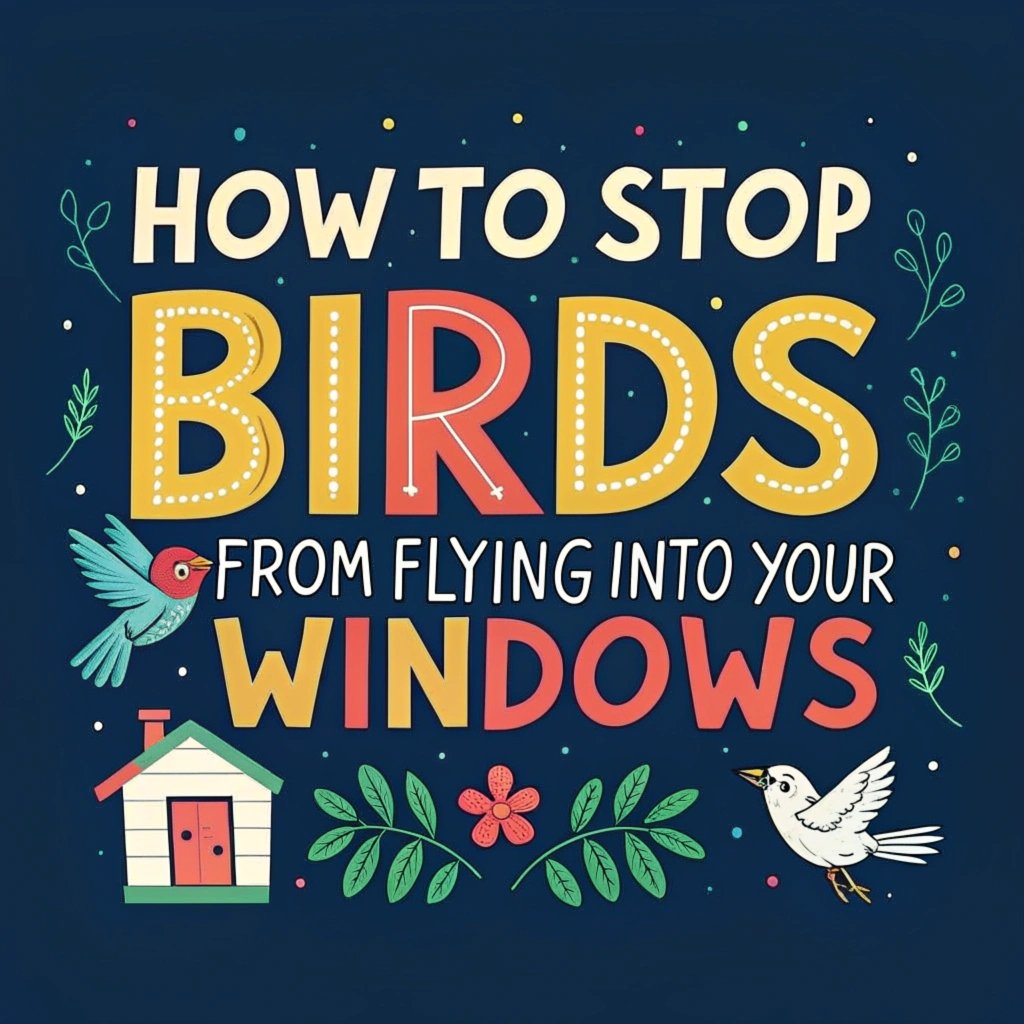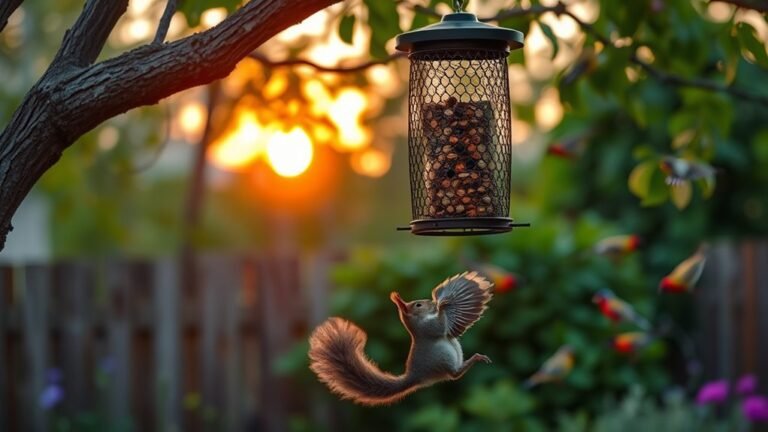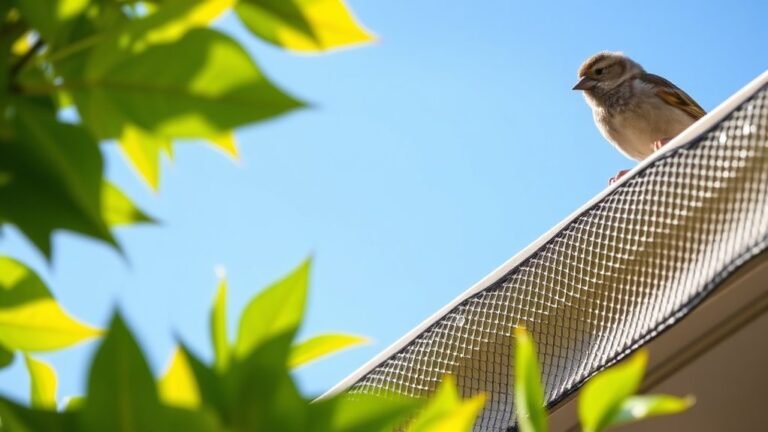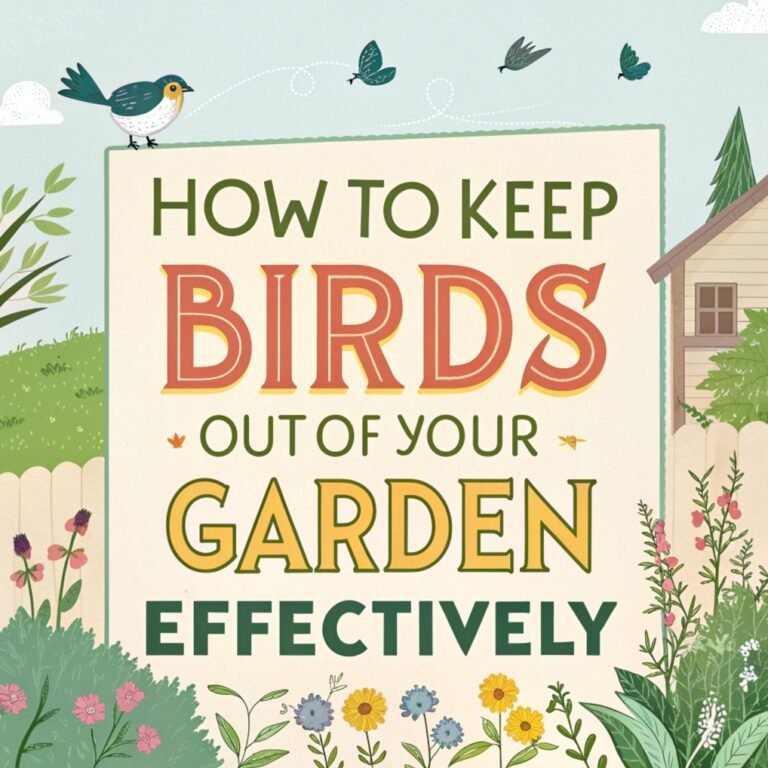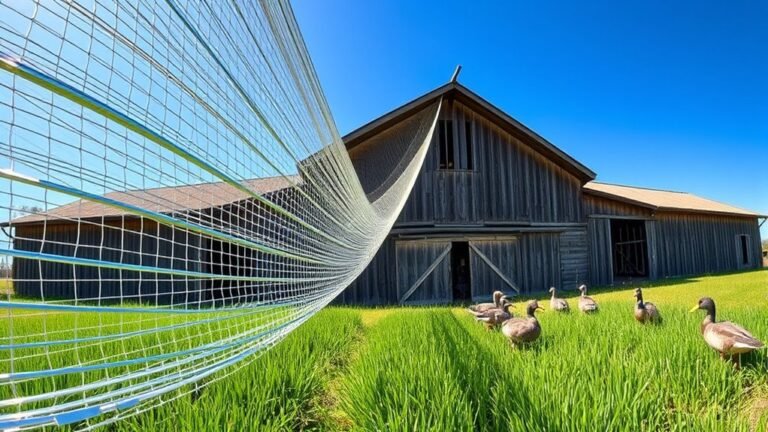How to Stop Birds from Flying into Your Windows: A Comprehensive Guide
The issue of birds flying into windows is not just a minor inconvenience; it’s a significant threat to our feathered friends.
Imagine waking up to the melodious chirping of birds, only to hear a sudden thud against your window. It’s a sound that breaks the heart of any bird lover and nature enthusiast.
Every year, countless birds lose their lives or suffer injuries due to these collisions, making it a pressing concern for homeowners and conservationists alike.
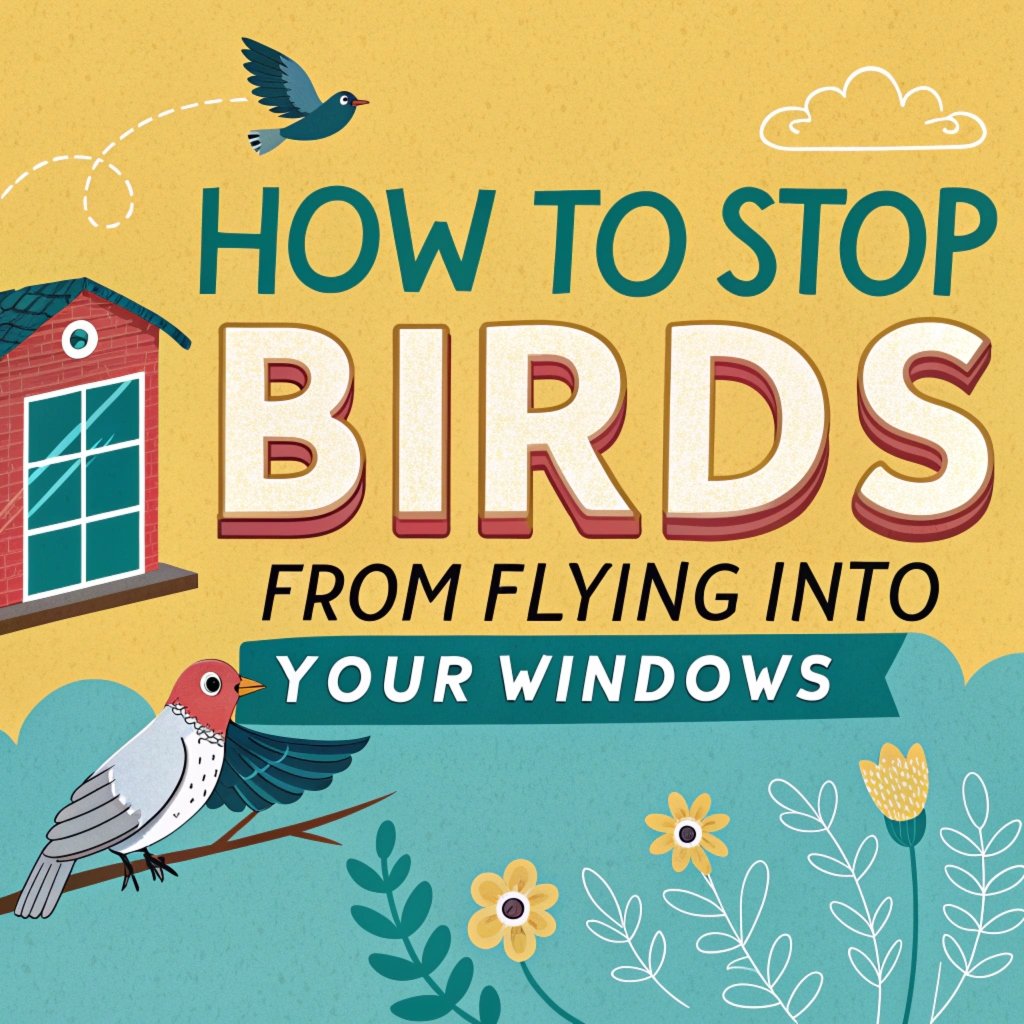
Key Takeaways:
Here’s a concise summary of the most important points to remember when preventing birds from flying into your windows:
- Understand the problem: Birds can’t perceive glass and often see reflections or through-views as open space, leading to collisions.
- Identify risky windows: Large picture windows, corner windows, and those near bird attractants are most dangerous.
- Quick fixes: Use soap to draw patterns on windows for immediate, temporary protection.
- Visual deterrents: Apply decals, stickers, or paint in dense patterns to make windows visible to birds.
- External barriers: Install screens, netting, or Zen curtains to prevent direct contact with glass.
- One-way films: Apply transparent films that allow views from inside but appear opaque from outside.
- Lighting adjustments: Reduce unnecessary lighting, especially during migration seasons, to prevent nighttime collisions.
- Feeder placement: Position bird feeders either very close (within 3 feet) or far (beyond 30 feet) from windows.
- Seasonal strategies: Implement extra precautions during spring and fall migration periods.
- Community action: Educate others and advocate for bird-safe practices in your community.
- Effective patterns: Use vertical stripes spaced 4 inches apart or horizontal stripes 2 inches apart for optimal protection.
- DIY solutions: Create your own deterrents using tempera paint or paracord for cost-effective protection.
- Nighttime precautions: Close curtains and blinds at night to reduce light emission from your home.
- Landscaping considerations: Plan your garden to redirect bird flight paths away from windows.
- Regular monitoring: Check windows frequently for signs of collisions to identify problem areas quickly.
Understanding the Problem: Why Birds Collide with Windows
Birds often collide with windows due to their inability to perceive glass as a solid barrier. When birds look at windows, they see reflections of trees, sky, or simply view through the glass, mistaking it for open space.
This optical illusion leads to potentially fatal collisions. The problem is particularly acute during migration seasons when birds are navigating unfamiliar territories.
Window strikes are a significant threat to bird populations, with nearly one billion birds colliding with glass in the U.S. annually.
Understanding this issue is crucial for developing effective prevention strategies. Birds’ visual perception differs from humans, making it challenging for them to recognize glass as an obstacle.
Reflective surfaces and transparent glass pose the greatest risks, especially when they mirror surrounding vegetation or provide a clear view through a building.
Identifying Dangerous Windows in Your Home
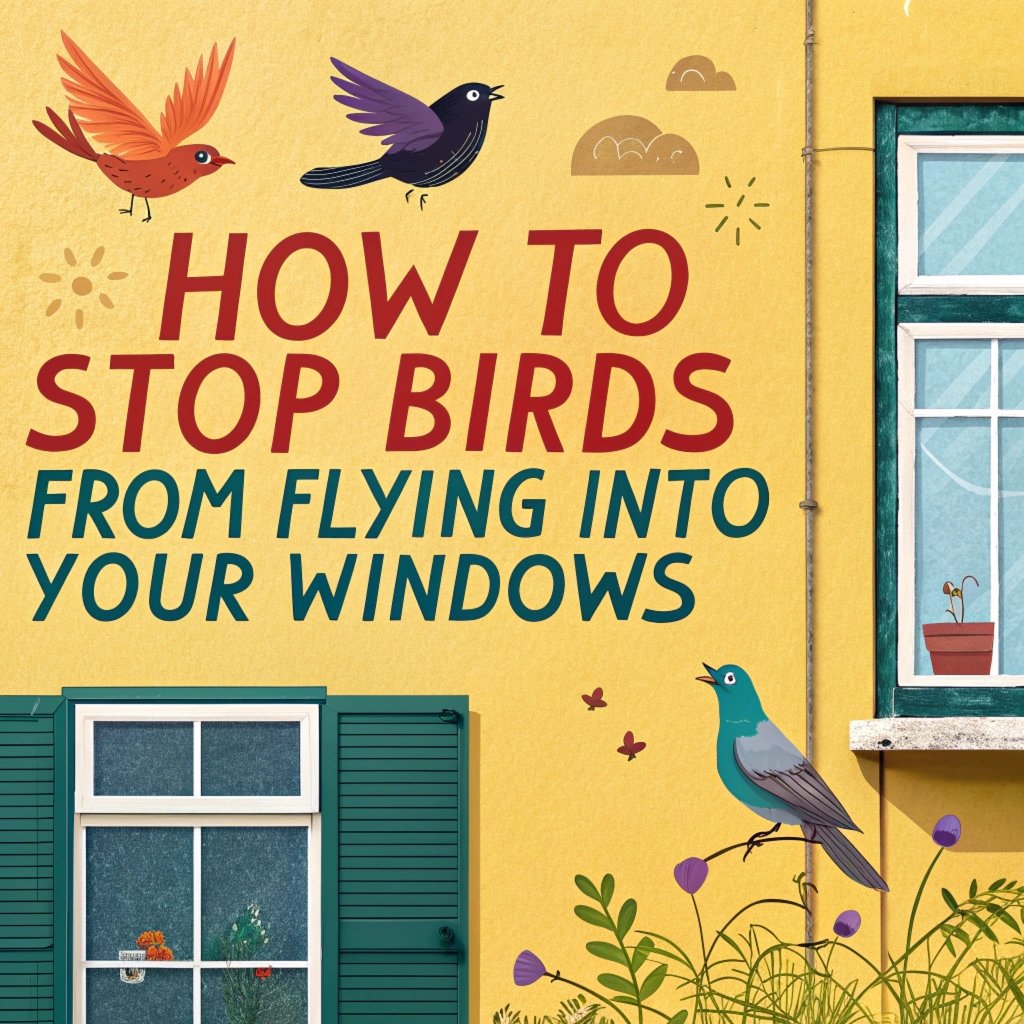
To effectively prevent bird collisions, it’s essential to identify the most dangerous windows in your home.
Large picture windows, paired windows at right angles, and windows with bird feeders nearby are often the most problematic.
Take time to observe your windows from a bird’s perspective. Step outside and look at your windows from different angles and distances.
If you see branches, sky, or other attractive elements reflected in or visible through the glass, birds will likely perceive the same illusion.
Pay attention to any previous collision marks on your windows, as these can indicate trouble spots.
Also, consider the location of bird attractants like water features, feeders, and dense vegetation near windows.
Quick and Temporary Solutions: Using Soap to Prevent Collisions
One of the quickest and most cost-effective methods to prevent bird collisions is using soap to create patterns on your windows.
This temporary solution can be implemented immediately to save birds‘ lives. Simply take a bar of soap and draw patterns on the outside of your window.
The soap creates a visible barrier that birds can detect, reducing the risk of collisions.
You can draw dots, lines, squiggles, or get creative with your designs. This method is particularly useful for sudden bird collision issues or during peak migration periods.
However, keep in mind that soap will need to be reapplied after heavy rains. While not a permanent solution, it’s an excellent stopgap measure until you can implement more long-lasting bird-safety measures.
Applying Window Decals and Stickers

Window decals and stickers are popular options for preventing bird collisions. These visual deterrents come in various forms, including hawk silhouettes, spider webs, and artistic designs.
However, it’s crucial to understand that the effectiveness of decals depends on their placement and density. Contrary to popular belief, a single hawk silhouette is not sufficient to deter birds.
For maximum effectiveness, decals should be placed close together, covering most of the glass surface.
The spaces between decals should be too narrow for birds to perceive as flythrough zones. Vertical stripes spaced no more than 4 inches apart or horizontal stripes no more than 2 inches apart are recommended.
Apply decals to the outside of the window for best results, as this helps break up reflections more effectively.
Using External Screens and Netting
External screens and netting are highly effective methods for preventing bird collisions. Insect screens serve a dual purpose by reducing window reflections and alerting birds to the presence of a barrier.
If your windows don’t have built-in screens, consider installing them not just for insect control but also for bird safety.
Alternatively, you can use netting placed a few inches away from the window. The netting should be taut enough to prevent birds from hitting the glass if they fly into it.
Choose small-mesh netting (around 5/8 inch or 1.6 cm) to ensure birds don’t get entangled. This method is particularly useful for large windows or glass doors.
You can mount the netting on a frame for easy installation and removal, making it a versatile solution for seasonal bird migration periods.
Implementing One-Way Transparent Films
One-way transparent films, such as Collidescape, offer an innovative solution to bird collisions while maintaining your view from inside.
These films allow people inside to see out clearly, but make the window appear opaque or patterned from the outside.
This effectively eliminates reflections and the illusion of open space that confuses birds.
While these films can slightly reduce the amount of light entering your home, they offer excellent protection for birds.
An added benefit is the potential reduction in cooling costs due to decreased solar heat gain.
One-way films are a particularly good option for large picture windows or in areas where aesthetics are a concern, as they provide a clean, uniform appearance from the outside.
Creating Visual Markers with Tempera Paint
Tempera paint offers another creative and effective method for preventing bird collisions. This non-toxic, long-lasting paint can be used to create patterns or artwork on the exterior of your windows.
The advantage of tempera paint is its durability – it can last for years but is easily removable with vinegar and water when needed.
You can create a grid pattern of 2-inch by 2-inch squares or let your artistic side shine with more elaborate designs. The key is to ensure that the painted areas are dense enough to be visible to birds.
Tempera paint is an excellent option for those who want a customizable, eco-friendly solution that can be changed seasonally or as desired.
Utilizing Zen Curtains for Elegant Protection
Zen curtains, also known as Acopian BirdSavers, offer an elegant and highly effective solution for preventing bird collisions.
These curtains consist of paracord strings hanging vertically in front of the window, spaced no more than 4 inches apart. The movement of these cords in the breeze creates a visual and auditory deterrent for birds.
This method is not only effective but also aesthetically pleasing, adding a unique architectural element to your windows.
Zen curtains can be purchased pre-made or easily constructed as a DIY project. They’re particularly suitable for large windows or sliding glass doors.
The simplicity and effectiveness of Zen curtains make them a popular choice among bird enthusiasts and environmentally conscious homeowners.
Adjusting Lighting to Reduce Nighttime Collisions
Many bird collisions occur at night, especially during migration seasons when birds are attracted to artificial lights.
Reducing unnecessary lighting, particularly during spring and fall migrations, can significantly decrease nighttime collisions.
Turn off exterior decorative lighting and close interior blinds or curtains to minimize light emission from your home.
For essential lighting, consider using motion sensors or timers to limit the duration of illumination.
When choosing outdoor lighting fixtures, opt for those that direct light downward rather than up into the sky or outward.
By making these simple adjustments, you can create a safer nighttime environment for migrating birds while also conserving energy.
Relocating Bird Feeders and Attractants
The placement of bird feeders and other attractants can significantly influence the likelihood of window collisions.
While it might seem counterintuitive, placing feeders either very close to windows (within 3 feet) or much farther away (beyond 30 feet) can help reduce collisions.
When feeders are close, birds don’t build up enough speed to hurt themselves if they do hit the window. When far away, birds have more space to maneuver and avoid collisions.
Consider the location of water features, bird baths, and dense vegetation as well. If these are near windows, birds may be more likely to fly towards the reflections they create.
By strategically placing these attractants, you can help guide birds to safer areas of your yard while still enjoying their presence.
Installing External Blinds or Shutters
External blinds or shutters provide an excellent barrier to prevent bird collisions while also offering additional benefits like improved energy efficiency and privacy.
Unlike internal blinds, external versions eliminate reflections and clearly signal to birds that the window is not a flythrough zone.
These can be particularly useful for windows that are prone to bird strikes or in areas with high bird activity.
Adjustable external blinds allow you to control the amount of light and visibility while providing consistent protection for birds. While this solution may require a larger initial investment, it offers long-term benefits for both bird safety and home comfort.
Implementing Seasonal Strategies for Migration Periods
Bird collision risks often peak during spring and fall migration periods. Implementing seasonal strategies can provide targeted protection when it’s most needed.
During these times, consider applying temporary solutions like soap markings or removable decals to windows that are typically not problematic year-round.
Be extra vigilant about lighting during migration seasons, particularly if you live in an area along major flyways.
You might also consider timing the placement of bird feeders and other attractants to avoid peak migration periods if they’re near risky windows.
By adapting your bird safety measures seasonally, you can provide critical protection when birds are most vulnerable without necessarily committing to year-round changes.
Educating Others and Promoting Bird-Safe Practices
Preventing bird collisions extends beyond individual efforts. Educating family members, neighbors, and your community about the importance of bird-safe windows can have a far-reaching impact.
Share your experiences and the methods you’ve found effective. Consider organizing community events or workshops to demonstrate bird-safe window treatments.
Advocate for bird-friendly building practices in your area, especially for new constructions or renovations.
Many modern architectural designs incorporate bird-safe features from the outset.
By spreading awareness and encouraging others to take action, you can contribute to a broader movement towards creating safer urban and suburban environments for our feathered friends.
FAQs
How effective are hawk silhouettes in preventing bird collisions?
Hawk silhouettes alone are not very effective in preventing bird collisions. While popular, they only work when applied in high densities. Birds quickly learn to ignore stationary objects. More effective methods include patterns covering a larger portion of the window or moving deterrents like Zen curtains.
Can I still enjoy birdwatching if I apply these prevention methods?
Absolutely! Many bird collision prevention methods, such as one-way transparent films or external screens, allow you to maintain clear visibility from inside your home. These solutions protect birds without significantly impacting your ability to observe and enjoy them.
How often do I need to reapply soap markings on my windows?
Soap markings typically need to be reapplied after heavy rains or every few weeks, depending on weather conditions. While not a permanent solution, they offer a quick and easy temporary fix, especially during migration seasons or until you can implement more long-term measures.
Are there any plants I can grow near my windows to deter bird collisions?
While plants themselves don’t deter collisions, strategic landscaping can help. Avoid placing attractive plants directly in front of windows. Instead, consider planting dense shrubs or trees a safe distance away to provide alternative perching spots and redirect flight paths away from windows.
How can I tell if a bird has hit my window?
Signs of bird collisions include feathers or smudge marks on the glass, the sound of an impact, or finding stunned or injured birds near your windows. Regularly checking your windows for these signs can help you identify problem areas that need attention.

Hello, I’m Amelia White, the founder of birdsfanatic.com. As a lifelong bird enthusiast and spiritual seeker, I’ve always been fascinated by the mystical connections between birds and the human experience. On this site, I share my knowledge and insights into the symbolic meanings and spiritual significance of various bird species, exploring their roles in mythology, folklore, and cultural traditions. Join me on this journey into the world of birds, where we’ll discover the hidden wisdom and guidance that these magnificent creatures have to offer.

